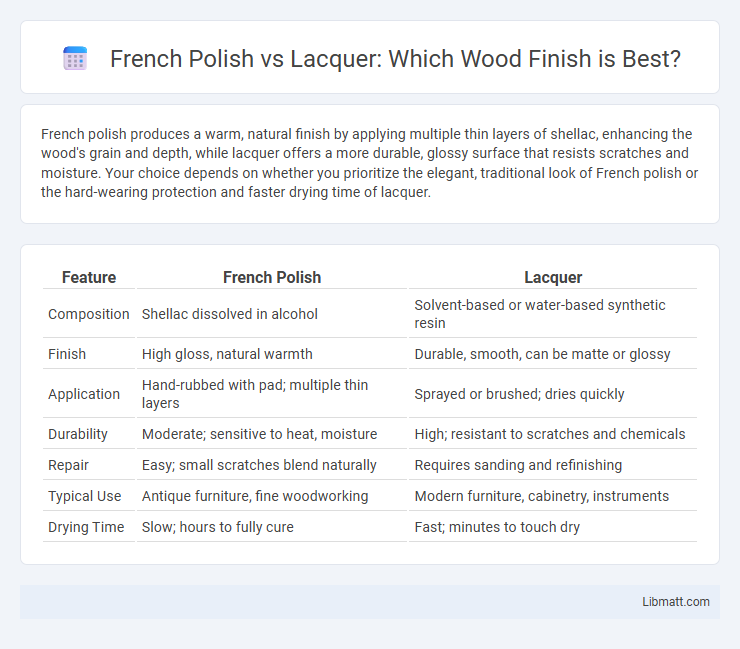French polish produces a warm, natural finish by applying multiple thin layers of shellac, enhancing the wood's grain and depth, while lacquer offers a more durable, glossy surface that resists scratches and moisture. Your choice depends on whether you prioritize the elegant, traditional look of French polish or the hard-wearing protection and faster drying time of lacquer.
Table of Comparison
| Feature | French Polish | Lacquer |
|---|---|---|
| Composition | Shellac dissolved in alcohol | Solvent-based or water-based synthetic resin |
| Finish | High gloss, natural warmth | Durable, smooth, can be matte or glossy |
| Application | Hand-rubbed with pad; multiple thin layers | Sprayed or brushed; dries quickly |
| Durability | Moderate; sensitive to heat, moisture | High; resistant to scratches and chemicals |
| Repair | Easy; small scratches blend naturally | Requires sanding and refinishing |
| Typical Use | Antique furniture, fine woodworking | Modern furniture, cabinetry, instruments |
| Drying Time | Slow; hours to fully cure | Fast; minutes to touch dry |
Introduction to French Polish and Lacquer
French polish is a traditional wood finishing technique using shellac applied in thin layers with a rubbing pad, resulting in a high-gloss, natural-looking surface that enhances wood grain depth. Lacquer is a modern finish made from synthetic or natural resins, delivering a durable, hard, and often glossy coating that protects wood from moisture and wear. Both methods provide distinct aesthetic and protective qualities, with French polish favored for antique furniture and lacquer preferred for contemporary and high-traffic applications.
Historical Background of French Polish and Lacquer
French polish originated in the 18th century as a traditional woodworking finish using shellac, prized for its high-gloss and deep, rich appearance. Lacquer traces its roots back to ancient Asian craftsmanship, particularly in China and Japan, where natural resins created durable, protective coatings. Your choice between these finishes reflects not only the desired aesthetic but also a connection to their distinct historical heritages and application methods.
Composition and Ingredients
French polish consists primarily of shellac dissolved in alcohol, providing a natural, glossy finish that enhances wood grain while remaining environmentally friendly. Lacquer is a synthetic coating made from cellulose nitrate or acrylic resins, designed for durability, rapid drying, and resistance to scratches and chemicals. Your choice between the two depends on whether you prioritize the traditional, breathable qualities of shellac or the protective, harder surface offered by lacquer.
Application Techniques Compared
French polish involves applying many thin layers of shellac with a rubbing pad, requiring skill and patience to achieve a high-gloss, smooth finish. Lacquer is sprayed or brushed on in multiple coats, drying quickly for easier and faster application, often resulting in a durable and even surface. The French polish technique emphasizes hand-rubbed craftsmanship, while lacquer relies on mechanical application methods.
Durability and Maintenance
French polish offers a high-gloss, natural wood finish but is less durable and more susceptible to water and heat damage compared to lacquer. Lacquer forms a hard, protective coating that resists scratches, chemicals, and moisture, making it ideal for high-traffic or frequently handled surfaces. Maintenance of French polish requires regular reapplication and careful cleaning, while lacquer surfaces need minimal upkeep and can be easily wiped clean.
Aesthetic Differences: Look and Feel
French polish creates a deep, rich, and glossy finish with a warm amber tone that enhances the natural grain of wood, offering a traditional and elegant appearance. Lacquer provides a smoother, more uniform surface that can range from matte to high gloss, delivering modern versatility with durable, scratch-resistant qualities. Your choice depends on whether you prefer the handcrafted depth of French polish or the clean, consistent shine of lacquer.
Environmental Impact and Safety
French polish uses shellac, a natural resin derived from insect secretions, making it biodegradable and less toxic, whereas lacquer contains synthetic chemicals and solvents that can release volatile organic compounds (VOCs), posing health risks and environmental concerns. You should consider that French polish offers a safer option with minimal air pollution, while lacquer requires proper ventilation and protective measures during application due to its flammable and harmful fumes. The environmental impact of lacquer manufacturing and disposal also tends to be higher compared to the more eco-friendly and sustainable French polish.
Cost and Accessibility
French polish typically costs less due to its use of shellac, a natural resin that is widely available and easy for DIYers to source and apply, making it an accessible option for refinishing furniture at home. Lacquer, while generally more expensive because of its synthetic formulation and professional application requirements, offers faster drying times and a durable finish favored in commercial settings. Your choice depends on balancing budget constraints with the desired finish quality and application ease.
Ideal Uses and Suitability
French polish provides a high-gloss, natural finish ideal for fine furniture, musical instruments, and antique restoration, where enhancing wood grain and traditional aesthetics are essential. Lacquer offers superior durability and quick drying times, making it suitable for modern furniture, cabinetry, and surfaces requiring robust protection against scratches and moisture. Your choice depends on the desired finish and the level of wear the surface will endure, with French polish favored for elegance and lacquer for resilience.
Conclusion: Choosing Between French Polish and Lacquer
French polish offers a rich, deep sheen and enhances the natural beauty of wood grain, ideal for antique furniture and fine woodwork restoration. Lacquer provides a durable, glossy finish with excellent resistance to moisture and wear, making it suitable for modern furniture and high-traffic surfaces. Your choice depends on whether you prioritize traditional elegance and subtlety or long-lasting protection and ease of maintenance.
French polish vs Lacquer Infographic

 libmatt.com
libmatt.com